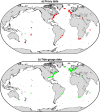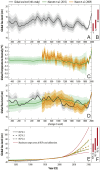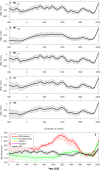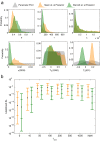Temperature-driven global sea-level variability in the Common Era
- PMID: 26903659
- PMCID: PMC4801270
- DOI: 10.1073/pnas.1517056113
Temperature-driven global sea-level variability in the Common Era
Erratum in
-
Correction for Kopp et al., Temperature-driven global sea-level variability in the Common Era.Proc Natl Acad Sci U S A. 2016 Sep 20;113(38):E5694-6. doi: 10.1073/pnas.1613396113. Epub 2016 Sep 12. Proc Natl Acad Sci U S A. 2016. PMID: 27621454 Free PMC article. No abstract available.
Abstract
We assess the relationship between temperature and global sea-level (GSL) variability over the Common Era through a statistical metaanalysis of proxy relative sea-level reconstructions and tide-gauge data. GSL rose at 0.1 ± 0.1 mm/y (2σ) over 0-700 CE. A GSL fall of 0.2 ± 0.2 mm/y over 1000-1400 CE is associated with ∼ 0.2 °C global mean cooling. A significant GSL acceleration began in the 19th century and yielded a 20th century rise that is extremely likely (probability [Formula: see text]) faster than during any of the previous 27 centuries. A semiempirical model calibrated against the GSL reconstruction indicates that, in the absence of anthropogenic climate change, it is extremely likely ([Formula: see text]) that 20th century GSL would have risen by less than 51% of the observed [Formula: see text] cm. The new semiempirical model largely reconciles previous differences between semiempirical 21st century GSL projections and the process model-based projections summarized in the Intergovernmental Panel on Climate Change's Fifth Assessment Report.
Keywords: Common Era; climate; late Holocene; ocean; sea level.
Conflict of interest statement
The authors declare no conflict of interest.
Figures







References
-
- Mann ME, et al. Global signatures and dynamical origins of the Little Ice Age and Medieval Climate Anomaly. Science. 2009;326(5957):1256–1260. - PubMed
-
- Marcott SA, Shakun JD, Clark PU, Mix AC. A reconstruction of regional and global temperature for the past 11,300 years. Science. 2013;339(6124):1198–1201. - PubMed
-
- PAGES 2K Consortium Continental-scale temperature variability during the past two millennia. Nat Geosci. 2013;6(5):339–346.
-
- Jevrejeva S, Grinsted A, Moore J. Anthropogenic forcing dominates sea level rise since 1850. Geophys Res Lett. 2009;36(20):L20706.
Publication types
LinkOut - more resources
Full Text Sources
Other Literature Sources

